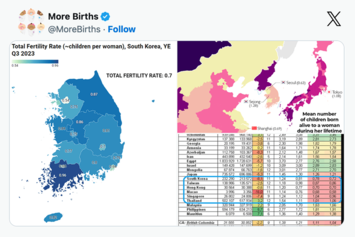
Nearly three months ago, I suggested that trying to get people to live in high-density housing projects was a good way to “kill a country” by reducing fertility rates. Not everyone was persuaded; one comment stated that there is “Not a shred of evidence other than his bald assertion that people in Korea have no room for kids.”
A Twitter user calling itself “More Births” has reached the same conclusion as the Antiplanner. After noting that South Korea, Taiwan, Singapore, and Thailand all have very low fertility rates, More Births asked what these regions have in common. The number 1 factor listed: ultra-dense housing policies.
As the Antiplanner noted, many factors affect fertility, and More Births included historic propaganda aimed at preventing overpopulation, Asia’s work culture, and low marriage rates. But density is still important; as More Births pointed out, density is a factor in differences in fertility in the U.S.
To be honest, I would feel more comfortable noting More Birth’s agreement with my hypothesis if I knew who More Births was. More Births is Daniel Hess, but I can’t find much information about him. More Birth’s Twitter page also says, “HT to Lyman Stone and other great demographers.” Lyman Stone is a researcher at the Institute for Family Studies who has written several articles about fertility rates in the United States.
Read the rest of this piece at The Antiplanner.
Randal O'Toole, the Antiplanner, is a policy analyst with nearly 50 years of experience reviewing transportation and land-use plans and the author of The Best-Laid Plans: How Government Planning Harms Your Quality of Life, Your Pocketbook, and Your Future.
Photo: Courtesy, The Antiplanner.












